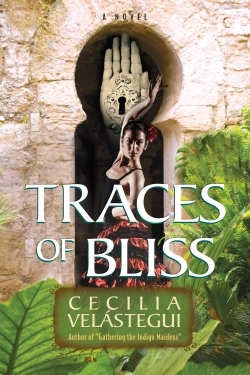Traces of Bliss
Much of the action in Traces of Bliss by Cecilia Velástegui takes place in present-day Los Feliz, a wealthy neighborhood in Los Angeles, but the central characters in this historical drama have connections to an ancient past. Americans of Hispanic origin, the characters are linked together by their mystical connection with the Spanish Inquisition.
The book opens as Claire, a massage therapist, begins to use verbena oil, an ancient Basque remedy, to treat her senior clients; the oil seems to stimulate their memories and dreams. Retired Judge Carrera begins to envision her life as a nun who adopted a baby girl abandoned at a convent in Medieval Spain. Mrs. Dougherty, left to grow old in the care of the solicitous Yolanda by her high-powered professional daughters, dreams of heretofore unknown passion in a cave with a handsome Basque adventurer. La Linda, a broken-howdy!down, formerly famous flamenco artist, feels her youthful vigor returning. Lecherous Dr. Nunez, going blind and assisted by his duplicitous caretaker, Soledad, has begun to experience a link to life in Medieval Granada as a Jewish poet. Mrs. Hamieh and her caregiver, Fatima, share an ability to interpret dreams, each sensing that Los Feliz is filled with both potent magic and grave danger.
All of them are being watched. A sinister figure, Alma Ruiz, is hovering around Los Feliz with an eye to bilking the neighborhood’s old folks out of their fortunes.
Traces of Bliss is full of surprises, switchbacks, and skillfully evoked vignettes of an ancient world of supernatural events that bleed into present-day reality. Its focus on strong but otherworldly females will remind some readers of the books of Isabel Allende and Margaret Atwood, while its blend of everyday happenings with step-through visions from the world of ghosts and spirits is reminiscent of Gabriel García Márquez and Mario Vargas Llosa. Velástegui, an Ecuadorian author who has also written Gathering the Indigo Maidens, spins her lush tale with a sense of the sacredness of inner vision. Hers is a celebration of language that readers have come to expect from Latin American writers; Velástegui deserves to be recognized as a distinguished member of that group.
Reviewed by
Barbara Bamberger Scott
Disclosure: This article is not an endorsement, but a review. The publisher of this book provided free copies of the book and paid a small fee to have their book reviewed by a professional reviewer. Foreword Reviews and Clarion Reviews make no guarantee that the publisher will receive a positive review. Foreword Magazine, Inc. is disclosing this in accordance with the Federal Trade Commission’s 16 CFR, Part 255.

